List of poker hands
In poker, players form sets of five playing cards, called hands, according to the rules of the game.[1] Each hand has a rank, which is compared against the ranks of other hands participating in the showdown to decide who wins the pot.[2] In high games, like Texas hold 'em and seven-card stud, the highest-ranking hands win. In low games, like razz, the lowest-ranking hands win. In high-low split games, both the highest-ranking and lowest-ranking hands win, though different rules are used to rank the high and low hands.[3][4]

Each hand belongs to a category determined by the patterns formed by its cards. A hand in a higher-ranking category always ranks higher than a hand in a lower-ranking category. A hand is ranked within its category using the ranks of its cards.[5] Individual cards are ranked, from highest to lowest: A, K, Q, J, 10, 9, 8, 7, 6, 5, 4, 3 and 2.[6] However, aces have the lowest rank under ace-to-five low or ace-to-six low rules, or under high rules as part of a five-high straight or straight flush.[7][8] Suits are not ranked, so hands that differ by suit alone are of equal rank.[9]
There are nine categories of hand when using a standard 52-card deck, except under ace-to-five low rules where straights, flushes and straight flushes are not recognized. An additional category, five of a kind, exists when using one or more wild cards. The fewer hands a category contains, the higher its rank.[10] There are 311,875,200 ways to deal five cards from the deck but only 2,598,960 distinct hands, because the order in which cards are dealt or arranged in a hand does not matter.[11] Moreover, since hands differing only by suit are of equal rank, there are only 7,462 distinct hand ranks.[12][13]
Hand-ranking categories
| * | Only possible when using one or more wild cards |
| ** | Category does not exist under ace-to-five low rules |
| Rank | Name | Example |
|---|---|---|
| 0 | Five of a kind* | 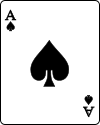  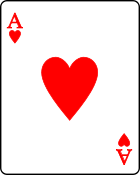   |
| 1 | Straight flush** |      |
| 2 | Four of a kind |      |
| 3 | Full house |      |
| 4 | Flush** |      |
| 5 | Straight** |      |
| 6 | Three of a kind |  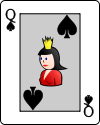   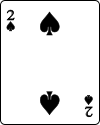 |
| 7 | Two pair |      |
| 8 | One pair |   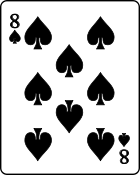   |
| 9 | High card |   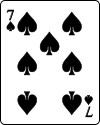   |
Five of a kind





Five of a kind is a hand that contains five cards of one rank, such as ("five of a kind, threes"). It ranks above a straight flush but is only possible when using one or more wild cards, as there are only four cards of each rank in the deck.[7] Five of a kind, aces, , becomes possible when a joker is added to the deck as a bug, a form of wild card that may act as a fifth ace.[6] Other wild card rules allow jokers or other designated cards to represent any card in the deck, making it possible to form five of a kind of any rank.[14]
Each five of a kind is ranked by the rank of its quintuplet. For example, ranks higher than .[7][15]
Straight flush





A straight flush is a hand that contains five cards of sequential rank, all of the same suit, such as (a "queen-high straight flush").[4] It ranks below five of a kind and above four of a kind.[6] Under high rules, an ace can rank either high (as in , an ace-high straight flush) or low (as in , a five-high straight flush), but cannot simultaneously rank both high and low (so is an ace-high flush).[7][15] Under deuce-to-seven low rules, an ace always ranks high (so is an ace-high flush). Under ace-to-six low rules, an ace always rank low (so is a king-high flush).[16] Under ace-to-five low rules, straight flushes are not possible (so is a nine-high hand).[8]
Each straight flush is ranked by the rank of its highest-ranking card. For example, ranks higher than , which ranks higher than . Straight flush hands that differ by suit alone, such as and , are of equal rank.[7][15]
An ace-high straight flush, such as , is called a royal flush or royal straight flush and is the best possible hand in high games when not using wild cards.[6][17][18] A five-high straight flush, such as , is called a steel wheel and is both the best low hand and usually the best high hand of the showdown in ace-to-five high-low split games.[4]
Four of a kind





Four of a kind, also known as quads, is a hand that contains four cards of one rank and one card of another rank (the kicker), such as ("four of a kind, nines"). It ranks below a straight flush and above a full house.[6]
Each four of a kind is ranked first by the rank of its quadruplet, and then by the rank of its kicker. For example, ranks higher than , which ranks higher than . Four of a kind hands that differ by suit alone, such as and , are of equal rank.[7][15]
Full house





A full house, also known as a full boat or a boat (and originally called a full hand), is a hand that contains three cards of one rank and two cards of another rank, such as (a "full house, threes over sixes" or "threes full of sixes" or "threes full").[19][20] It ranks below four of a kind and above a flush.[6]
Each full house is ranked first by the rank of its triplet, and then by the rank of its pair. For example, ranks higher than , which ranks higher than . Full house hands that differ by suit alone, such as and , are of equal rank.[7][15]
Flush





A flush is a hand that contains five cards all of the same suit, not all of sequential rank, such as (a "king-high flush" or a "king-ten-high flush").[21] It ranks below a full house and above a straight.[6] Under ace-to-five low rules, flushes are not possible (so is a jack-high hand).[8]
Each flush is ranked first by the rank of its highest-ranking card, then by the rank of its second highest-ranking card, then by the rank of its third highest-ranking card, then by the rank of its fourth highest-ranking card, and finally by the rank of its lowest-ranking card. For example, ranks higher than , which ranks higher than , which ranks higher than , which ranks higher than , which ranks higher than . Flush hands that differ by suit alone, such as and , are of equal rank.[7][15]
Straight





A straight is a hand that contains five cards of sequential rank, not all of the same suit, such as (a "seven-high straight"). It ranks below a flush and above three of a kind.[6] Under high rules, an ace can rank either high (as in , an ace-high straight) or low (as in , a five-high straight), but cannot simultaneously rank both high and low (so is an ace-high hand).[7][15] Under deuce-to-seven low rules, an ace always ranks high (so is an ace-high hand). Under ace-to-six low rules, an ace always ranks low (so is a king-high hand).[16] Under ace-to-five low rules, straights are not possible (so is a ten-high hand).[8]
Each straight is ranked by the rank of its highest-ranking card. For example, ranks higher than , which ranks higher than . Straight hands that differ by suit alone, such as and , are of equal rank.[7][15]
An ace-high straight, such as , is called a Broadway straight,[22] while a five-high straight, such as , is called a baby straight,[23] bicycle or wheel and is the best possible hand in ace-to-five low games (where it is a high card hand, not a straight).[24][25]
Three of a kind





Three of a kind, also known as trips or a set, is a hand that contains three cards of one rank and two cards of two other ranks (the kickers), such as ("three of a kind, twos" or "trip twos" or a "set of twos"). It ranks below a straight and above two pair.[6]
Each three of a kind is ranked first by the rank of its triplet, then by the rank of its highest-ranking kicker, and finally by the rank of its lowest-ranking kicker. For example, ranks higher than , which ranks higher than , which ranks higher than . Three of a kind hands that differ by suit alone, such as and , are of equal rank.[7][15]
In community card games, such as Texas hold 'em, three of a kind is called a set only when it comprises a pocket pair and a third card on the board.[26]
Two pair





Two pair is a hand that contains two cards of one rank, two cards of another rank and one card of a third rank (the kicker), such as ("two pair, jacks and fours" or "two pair, jacks over fours" or "jacks up").[19][27] It ranks below three of a kind and above one pair.[6]
Each two pair is ranked first by the rank of its highest-ranking pair, then by the rank of its lowest-ranking pair, and finally by the rank of its kicker. For example, ranks higher than , which ranks higher than , which ranks higher than . Two pair hands that differ by suit alone, such as and , are of equal rank.[7][15]
One pair





One pair, or simply a pair, is a hand that contains two cards of one rank and three cards of three other ranks (the kickers), such as ("one pair, fours" or a "pair of fours"). It ranks below two pair and above high card.[6]
Each one pair is ranked first by the rank of its pair, then by the rank of its highest-ranking kicker, then by the rank of its second highest-ranking kicker, and finally by the rank of its lowest-ranking kicker. For example, ranks higher than , which ranks higher than , which ranks higher than , which ranks higher than . One-pair hands that differ by suit alone, such as and , are of equal rank.[7][15]
High card





High card, also known as no pair or simply nothing, is a hand that does not fall into any other category, such as ("high card, king" or "king-jack-high" or "king-high").[19][28] Note that under ace-to-five low rules, straights, flushes and straight flushes are not possible, so such hands are instead high card hands.[8] It ranks below one pair.[6]
Each high card hand is ranked first by the rank of its highest-ranking card, then by the rank of its second highest-ranking card, then by the rank of its third highest-ranking card, then by the rank of its fourth highest-ranking card, and finally by the rank of its lowest-ranking card. For example, ranks higher than , which ranks higher than , which ranks higher than , which ranks higher than , which ranks higher than . High card hands that differ by suit alone, such as and , are of equal rank.[7][15]
Under deuce-to-seven low rules, a seven-five-high hand, such as , is the best possible hand.[29] Under ace-to-six low rules, where aces have the lowest rank, a six-four-high hand, such as , is the best possible hand.[30] Under ace-to-five low rules, where aces have the lowest rank and straights, flushes and straight flushes are not possible, a five-high hand, such as or , commonly known as a bicycle or wheel, is the best possible hand.[8][24]
See also
- Glossary of poker terms
- List of playing-card nicknames
- Non-standard poker hand
- Poker probability – in-depth analysis of poker hand probabilities
References
- Krieger, Lou (2006). "What is Poker?". The Poker Player's Bible. South Africa: Struik Publishers. pp. 12–14. ISBN 978-1-77007-469-9.
- Harrock, Richard (2011). "The Basics of Play". Poker for Dummies, Mini Edition. United States of America: Wiley Publishing, Inc. ISBN 978-0-470-05565-6.
- Sklansky, David (2005). The Theory of Poker. United States of America: Two Plus Two Publishing LLC. pp. 2. ISBN 1-880685-00-0.
- Braids, Sam (2003). The Intelligent Guide to Texas Hold'em. Towson, Maryland: Intelligent Games Publishing. pp. 166. ISBN 0-9677551-2-3.
- "Poker Hands Order – Poker Hand Rankings at PokerStars". www.pokerstars.com. Retrieved 12 July 2016.
- Krieger, Lou (2006). The Poker Player's Bible. South Africa: Struik Publishers. pp. 30–34. ISBN 978-1-77007-469-9.
- Greiner, Ron (2005). The Everyday Guide to Recreational Poker. Everyday Endeavors, LLC. pp. 46–60. ISBN 0-9769703-0-9.
- Scott, Alex (2010). "How to Play Lowball Draw". What I Know about Poker: Lessons in Texas Hold'em, Omaha and Other Poker Games. p. 24. ISBN 978-0-9567151-3-5.
- "Poker Hand Ranking | Official World Series of Poker Online". www.wsop.com. Retrieved 12 July 2016.
- "Probability: 5-Card Poker Hands". www.math.hawaii.edu. Retrieved 12 July 2016.
- Bourne, Murray. "Probability and Poker". www.intmath.com. Retrieved 12 July 2016.
- Berg, Henry (13 May 2013). "FiveCardSingleDeckHands.txt". Code Throwdown. Retrieved 13 July 2016.
- "How many poker hands are there?". Retrieved 13 July 2016.
- Rigal, Barry (2005). Card Games For Dummies. 111 River Street, Hoboken, NJ, USA: John Wiley & Sons. pp. 284. ISBN 978-0-7645-9910-1.CS1 maint: location (link)
- Kreiger, Lou; Bykofsky, Sheree (2006). The Rules of Poker. Lyle Stuart. pp. 99–102. ISBN 0-8184-0660-7.
- "Lowball Hand Rankings". playlowballpoker.com. Retrieved 5 August 2016.
- Miller, Ed; Sklansky, David; Malmuth, Mason (2005). Small Stakes Hold 'em. United States of America: Two Plus Two Publishing LLC. pp. 343–358. ISBN 1-880685-32-9.
- Taylor, David G. (2015). The Mathematics of Games: An Introduction to Probability. CRC Press. pp. 49–51. ISBN 978-1-4822-3543-2.
- Wenzel, John (2004). The Everything Poker Strategy Book. United States of America: F+W Publications, Inc. pp. 6–10. ISBN 1-59337-140-3.
- "Online Etymology Dictionary". www.etymonline.com. Retrieved 1 August 2016.
- Sklansky, David (2007). The Theory of Poker. Two Plus Two Publishing LLC. pp. 124. ISBN 1-880685-00-0.
- Erickson, David (2015). "3.2.5.3 Broadway straight". Superior Texas Hold'em: Evolved Poker Strategy. United States of America: Evergent Teknologies. ISBN 978-0-9938197-0-4.
- Zee, Ray (2007). High-Low-Split Poker, Seven-Card Stud and Omaha Eight-or-better for Advanced Players. United States of America: Two Plus Two Publishing LLC. p. 323. ISBN 978-1-880685-10-5.
- Sklansky, David (2005). "Glossary of Poker Terms". The Theory of Poker. United States of America: Two Plus Two Publishing LLC. pp. 277–293. ISBN 1-880685-00-0.
- Malmuth, Mason (1998). "Ace-to-Five Lowball". Winning Concepts in Draw and Lowball (2nd ed.). United States of America: Two Plus Two Publishing. p. 45. ISBN 1-880685-07-8.
- Sklansky, David (2004). Small Stakes Hold 'Em (1 ed.). Two Plus Two Publishing. p. 127. ISBN 978-1-880685-32-7.
- Cardoza, Avery (2012). Poker Talk. Cardoza Publishing. ISBN 978-1-58042-502-5.
- Gelling, Jonathan (2009). Poker Tips that Pay. Play to Pay Publishing. p. 333. ISBN 978-0-9840822-9-2.
- Kimberg, Daniel (2002). Serious Poker. ConJelCo LLC. pp. 229–277. ISBN 1-886070-16-4.
- "WSOP | How To Play | How To Play Lowball Poker". www.wsop.com. Retrieved 4 August 2016.
External links
